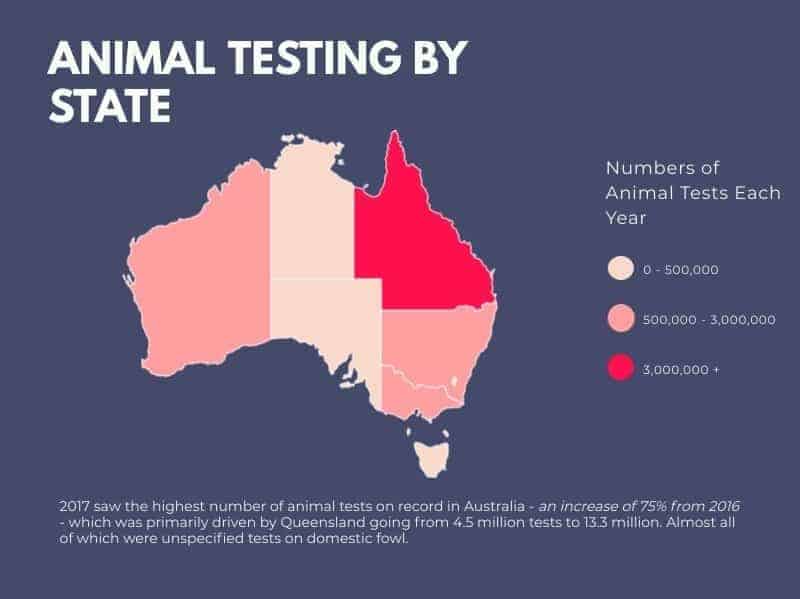- This post may contain affiliate links which - at no cost to you - may generate a small fee for us. It helps us research and review products more effectively
- Australia passed a nationwide ban on cosmetic animal testing on July 1st 2020
- But between 2004 – 2017, animal testing procedures increased by 211%
- Unspecified tests, environmental studies and biological understanding are the top 3 ‘reasons’ for animal tests in Australia
Is Animal Testing Illegal in Australia?
On July 1st 2020, Australia implemented a complete ban on cosmetic animal testing.
This means that new ingredients used exclusively in cosmetics cannot use information from animal testing to prove safety. This includes ingredients manufactured OR imported into Australia.
Bonzer.
How is Australia’s Ban on Cosmetic Animal testing Implemented?
- Legislation – a national regulatory scheme
- The National Health and Medical Research Council works with state and territory governments
- The Department has created a voluntary code of practice in conjunction with the cosmetics industry
- A cross-industry advisory group supports measures
As changes have been made to the Australian Code for the Care and Use of Animals for Scientific Purposes – wordy – it’s entirely reasonable to suggest people and companies will need some form of support. So it’s encouraging to see the Australian government put in place supportive and preventative measures.
This includes a voluntary code of practice which will help guide promotional or advertising claims targeting consumers in a bid to stem the spread of misinformation.
And the advisory group includes: researchers, animal welfare organisations, cosmetic industry and government representatives. Incredibly all-encompassing.
How Many Animals Die From Animal Testing Each Year in Australia?
364,774 animals died in 2017 in Australia as a result of animal testing. And Australia is likely the world’s third largest proponent of animal testing.
20,089 of these animals were subjected to a procedure that ended with death. A further 344,685 were rendered unconscious – to prevent procedural pain – and didn’t regain consciousness.
This doesn’t include the 196,339 animals who endured procedures that ended with major physiological damage.
Animal Testing by Australian State
The most recent data on animal testing in Australia highlights just how prevalent procedures on animals have become. 2017 saw an overall increase of 75% on the previous year. Which is scary.
And although there has been a ban on cosmetic animal testing in 2020, the majority of these tests aren’t for cosmetic purposes.
‘How do we know’ I hear you ask. Because domestic fowl – the most used animals – aren’t suitable for cosmetic testing.

8 Scariest Statistics About Animal Testing in Australia
The last updated Australian animal testing statistics are from 2017. Fortunately, there is animal testing data from 2004 and that has helped us breakdown exactly how animal testing in Australia has evolved over time.
Some of these numbers – particularly the unspecified procedures – are a little scary. And any tests on dogs and cats is always crushing.
How Many Animals Are Used For Testing in Australia?
1. 20,160,000 estimated procedures on animals in 2017
This is a 75% increase on the 12,000,000 animal tests in Australia in 2016. An extraordinary increase – primarily led by unspecified testing on domestic fowl in Queensland.
2. 13,300,000 Estimated procedures on domestic fowl in 2017 in Queensland alone
From 4.5 million animal tests in 2016 to 13.3 million in 2017 – Queensland’s 196% increase was almost entirely driven by unspecified testing on fowl.
What Animal Testing is Used for in Australia?
3. 20% animal procedures were for environmental studies
Typically animal testing studies that have an environmental benefit, are to look at the impact of certain chemicals on the environment. Which, as animal testing has a negative impact on the environment – animals have energy intensive needs and these facilities create a lot of waste.
4. 65% animal procedures were for unspecified reasons
Unspecified tests of any kind are frightening. Particularly when they focus on animals. And the detail behind these tests has never been released.
5. 5% animal procedures were for understanding human biology
Whilst it is almost impossible to run experiments on humans, testing on animals is used to understand what happens when bodies are put under new or undue stress. Unfortunately this is still very prevalent in Australia.
What Animals are Used for Testing in Australia?
6. 65% animal procedures were undertaken on wildfowl
7. 13% animal procedures were undertaken on fish
8. 9% animal procedures were undertaken on native mammals
9. 18,227 procedures on dogs, cats, horses / donkeys and primates
What are Australia’s Animal Testing Laws?
National Health and Medical Research Council (NHMRC)
The NHMRC created a special code of ethics for animal usage in scientific experiments. Whilst the code preaches the ethical, humane treatment of animals, it places responsibility on those conducting the research. An essential factor in humane research.
National Animal Welfare Ban
The National Animal Welfare Ban was implemented in 2005. It was created to satiate public demand for better conditions for animals – 85% of Australian’s are against animal testing – and the scientific community.
Fortunately this bill has been built on since 2005.
Cosmetic Testing Ban
Australia’s Cosmetic Ban on Animal Testing came into play in 2020.
This is a huge step forward in the fight for animal equality and we need more countries to follow suit. Only around 20% of the world’s countries have a nationwide ban on cosmetic animal testing. 20%.
